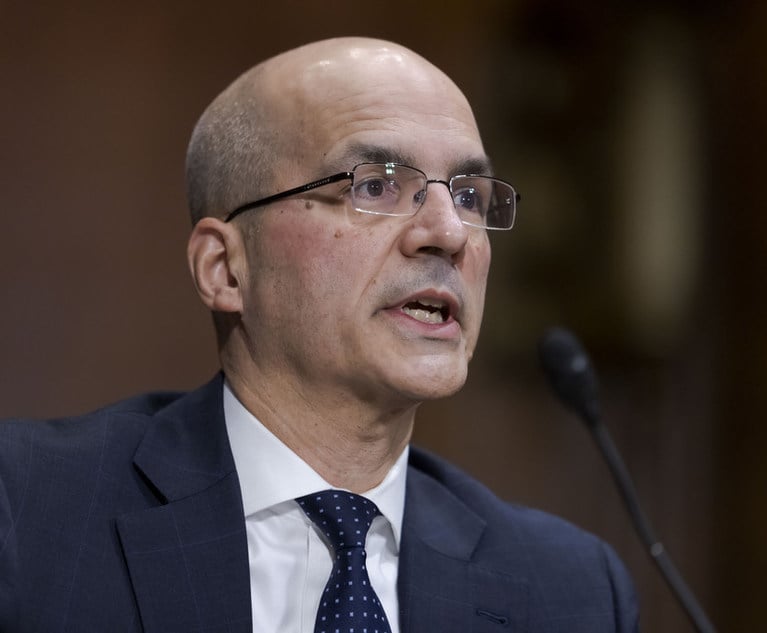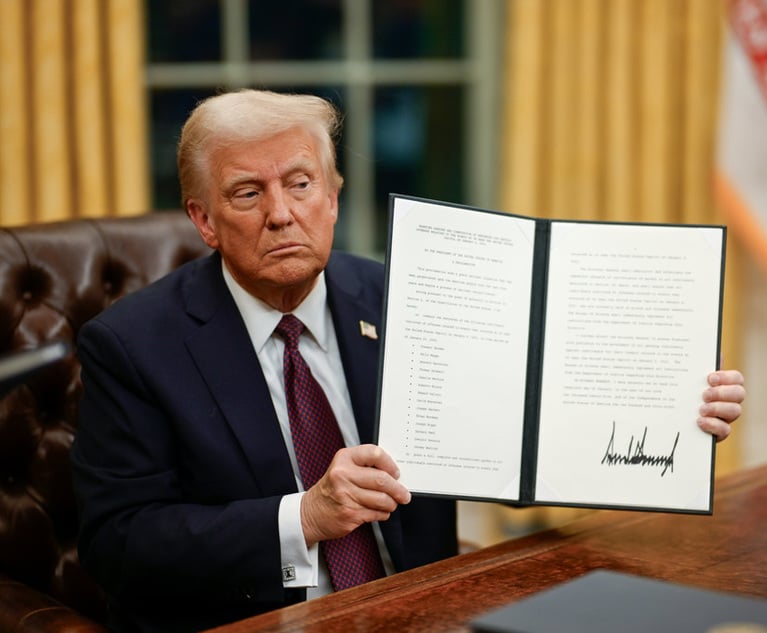Disclosure of the CEO Pay Ratio: Potential Impact on Stakeholders
Executive Compensation columnist Joseph E. Bachelder III writes: 2018 is the first year in which public companies have been required to report the “CEO Pay Ratio.” The CEO Pay Ratio for a reporting company represents the ratio of the total pay of the CEO to the total pay of the “median employee” at that company.
September 27, 2018 at 02:35 PM
8 minute read
 Joseph E. Bachelder III
Joseph E. Bachelder III
2018 is the first year in which public companies have been required to report the “CEO Pay Ratio.” The CEO Pay Ratio for a reporting company represents the ratio of the total pay of the CEO to the total pay of the “median employee” at that company. This requirement is contained in Item 402(u) of Regulation S-K and applies to fiscal years beginning on or after Jan. 1, 2017. (17 CFR §229.402(u).) It does not apply to emerging growth companies, smaller reporting companies and foreign private issuers.
Following is a description of steps involved in calculating the CEO Pay Ratio as it appears in the proxy statement.
Step 1: Determine “CEO Pay” for the fiscal year in question. CEO Pay means total pay of the CEO determined on the same basis as total pay for purposes of the Summary Compensation Table in the proxy statement. This amount typically includes salary, annual bonus, long-term incentive awards, perquisites and benefits.
Step 2: Determine the group of “covered employees.” The determination is to be made as of a fixed date within the last three months of the fiscal year in question. The “covered employee” group includes all full-time, part-time, seasonal and temporary employees. It excludes independent contractors. Item 402(u) contains numerous exceptions as to the definition of “employee.”
Step 3: Determine the “median employee” for the group of “covered employees.” The “median employee” is the employee whose annual pay is equal to the median annual pay for the “covered employee” group excluding the CEO. For this purpose, Item 402(u) provides that the employer may use a consistently applied measure of employee pay such as W-2 income. (The “median employee,” once identified, becomes the “median employee” for a three-year period unless, for the year prior to the reporting year in question, a change in the employee population or in the employee compensation arrangements occurs that would cause a significant change in the CEO Pay Ratio.)
Step 4: Determine the Median Employee Pay for the fiscal year in question. Once the “median employee” is identified as just described in Step 3 the employer must recalculate the total pay of the “median employee” using the same methodology used in calculating CEO Pay in Step 1.
Step 5: Calculate the CEO Pay Ratio. This is calculated by dividing the CEO Pay determined in Step 1 by the Median Employee Pay as determined in Step 3.
To illustrate: Assume CEO Pay at the reporting company (Step 1) is $5,400,000 for the fiscal year in question and that the Median Employee Pay for that year (Step 4) is $60,000. The CEO Pay Ratio would be 90:1.
The components of the CEO Pay Ratio were the subject of a column by the author published in the New York Law Journal Dec. 18, 2015.
Recent Report on 2017 Pay and CEO Pay Ratio Data
Levels of CEO Pay, Median Employee Pay and the CEO Pay Ratio at the Russell 3000 for fiscal year 2017 were reported by Compensation Advisory Partners in a post titled “CEO Pay Ratio—Russell 3000 Data” (updated as of Sept. 1, 2018). The post covers 2,068 Russell 3000 companies and reports the following:
CEO Pay. The median CEO Pay for the companies reporting was approximately $4.7 million. The 25th and 75th percentiles were approximately $2.3 million and $8.5 million, respectively.
Median Employee Pay. The median of the Median Employee Pay levels for the companies reporting was approximately $63,000. The 25th and 75th percentiles were approximately $44,000 and $100,000, respectively.
CEO Pay Ratio. The median CEO Pay Ratio for the companies reporting was 70:1. The 25th and 75th percentiles were 33:1 and 144:1, respectively.
CEO Pay Ratios vary significantly by company size. They range from a median CEO Pay Ratio of 27:1 for companies with revenues less than $0.5 billion (659 companies) to a median CEO Pay Ratio of 230:1 for companies with revenues greater than $15 billion (149 companies).
CEO Pay Ratios also vary significantly by different industry sectors. They range from a median CEO Pay Ratio of 40:1 for companies in the Financials sector (401 companies) to a median CEO Pay Ratio of 186:1 for companies in the Consumer Discretionary sector (288 companies).
Impact on Several Constituencies of CEO Pay Ratio Disclosure
The following discussion considers the impact of the CEO Pay Ratio (and related disclosures) on several constituencies: shareholders, directors and employees.
Impact on Shareholders. According to a recent report, approximately 97.4 percent of the Russell 3000 companies who reported holding a Say on Pay vote in 2018 had a favorable vote from a majority of shareholders on the executive compensation programs. Approximately 2.6 percent failed the Say on Pay vote. 1909 companies reported. The report, “2018 Say on Pay and Proxy Results—Russell 3000,” was published by Semler Brossy July 12, 2018.
Of the 1,909 companies noted in the Semler Brossy report, 1,611 reported disclosing the CEO Pay Ratio to their shareholders. Those with a CEO Pay Ratio above the median for this group had an average favorable Say on Pay vote of 89.3 percent; those with a CEO Pay Ratio below the median for the group had an average favorable Say on Pay vote of 91.8 percent. The difference in these two percentages is not statistically significant suggesting that the CEO Pay Ratio did not impact significantly on the Say on Pay vote in 2018.
The CEO Pay Ratio is only one of numerous factors that impact on shareholders' Say on Pay votes. (One of the most important presumably is the stock price.) Since 2018 is the first year of CEO Pay Ratio disclosure, it is too early to say what the ultimate impact of the pay ratio disclosure may be. Investors may have a different point of view after several years of seeing disclosures of the CEO Pay Ratio and the Median Employee Pay and changes in each of these.
Impact on Directors. Most compensation committees probably have not considered who a “midpoint” employee is or what his or her pay is. Under the new disclosure rules, when a compensation committee oversees the presentation in the proxy statement of the CEO Pay Ratio and the Median Employee Pay a number of factors will need to be considered by the committee:
(1) How do the CEO Pay Ratio and the Median Employee Pay at the company compare with the CEO Pay Ratio and the Median Employee Pay, respectively, at comparable companies?
(2) What effect will the publication of the CEO Pay Ratio and the Median Employee Pay—more so of the latter than the former—have on employee morale? (See discussion in next section.) What should directors do in this regard?
(3) What effect will the publication of the CEO Pay Ratio and the Median Employee Pay have on the company's stock price? What should directors do in this regard?
(4) Has there been a significant change in the CEO Pay Ratio at the company over the past year, or over the past several years? If so, why? How does it relate to the change in Median Employee Pay? How does it compare with changes in the CEO Pay Ratio at other companies?
Impact on Employees. Many employees will be upset to learn, as part of the CEO Pay Ratio disclosure, that their pay levels are below the Median Employee Pay level at their employer (or at one or more companies that are comparable to the employer). An example of what can occur was reported recently in an article entitled “Wells Fargo CEO's pay details spark pushback by some employees,” published by Reuters April 23, 2018. Wells Fargo provided employees an internal communications website. Following the CEO Pay Ratio disclosure in mid-March, “[m]ore than a dozen employees made posts criticizing pay details the bank released in March,” according to the article. The article also states: “After several days, Wells Fargo closed the notice board to new posts, writing that some comments do not comply with company policies, according to the internal discussion. A company spokeswoman confirmed the discussion had been closed.”
Conclusion
An important effect of the pay and pay ratio disclosures, as noted, may be an upward pressure on employee pay levels. Much of the upward pressure on CEO pay began in the 1930s with the disclosure of CEO pay in proxy statements. Disclosure in proxy statements, starting in 2018, of the CEO Pay Ratio, including disclosure of Median Employee Pay, may have a similar effect on levels of employee pay generally.
Joseph E. Bachelder III is special counsel to McCarter & English. Andy Tsang, a senior financial analyst with the firm, assisted in the preparation of this column.
This content has been archived. It is available through our partners, LexisNexis® and Bloomberg Law.
To view this content, please continue to their sites.
Not a Lexis Subscriber?
Subscribe Now
Not a Bloomberg Law Subscriber?
Subscribe Now
NOT FOR REPRINT
© 2025 ALM Global, LLC, All Rights Reserved. Request academic re-use from www.copyright.com. All other uses, submit a request to [email protected]. For more information visit Asset & Logo Licensing.
You Might Like
View All
'A Shock to the System’: Some Government Attorneys Are Forced Out, While Others Weigh Job Options
7 minute read
'Serious Legal Errors'?: Rival League May Appeal Following Dismissal of Soccer Antitrust Case
6 minute read
How Some Elite Law Firms Are Growing Equity Partner Ranks Faster Than Others
4 minute read
Trending Stories
- 1Recent Controversial Decision and Insurance Law May Mitigate Exposure for Companies Subject to False Claims Act Lawsuits
- 2Visa Revocation and Removal: Can the New Administration Remove Foreign Nationals for Past Advocacy?
- 3Your Communications Are Not Secure! What Legal Professionals Need to Know
- 4Legal Leaders Need To Create A High-Trust Culture
- 5There's a New Chief Judge in Town: Meet the Top Miami Jurist
Who Got The Work
J. Brugh Lower of Gibbons has entered an appearance for industrial equipment supplier Devco Corporation in a pending trademark infringement lawsuit. The suit, accusing the defendant of selling knock-off Graco products, was filed Dec. 18 in New Jersey District Court by Rivkin Radler on behalf of Graco Inc. and Graco Minnesota. The case, assigned to U.S. District Judge Zahid N. Quraishi, is 3:24-cv-11294, Graco Inc. et al v. Devco Corporation.
Who Got The Work
Rebecca Maller-Stein and Kent A. Yalowitz of Arnold & Porter Kaye Scholer have entered their appearances for Hanaco Venture Capital and its executives, Lior Prosor and David Frankel, in a pending securities lawsuit. The action, filed on Dec. 24 in New York Southern District Court by Zell, Aron & Co. on behalf of Goldeneye Advisors, accuses the defendants of negligently and fraudulently managing the plaintiff's $1 million investment. The case, assigned to U.S. District Judge Vernon S. Broderick, is 1:24-cv-09918, Goldeneye Advisors, LLC v. Hanaco Venture Capital, Ltd. et al.
Who Got The Work
Attorneys from A&O Shearman has stepped in as defense counsel for Toronto-Dominion Bank and other defendants in a pending securities class action. The suit, filed Dec. 11 in New York Southern District Court by Bleichmar Fonti & Auld, accuses the defendants of concealing the bank's 'pervasive' deficiencies in regards to its compliance with the Bank Secrecy Act and the quality of its anti-money laundering controls. The case, assigned to U.S. District Judge Arun Subramanian, is 1:24-cv-09445, Gonzalez v. The Toronto-Dominion Bank et al.
Who Got The Work
Crown Castle International, a Pennsylvania company providing shared communications infrastructure, has turned to Luke D. Wolf of Gordon Rees Scully Mansukhani to fend off a pending breach-of-contract lawsuit. The court action, filed Nov. 25 in Michigan Eastern District Court by Hooper Hathaway PC on behalf of The Town Residences LLC, accuses Crown Castle of failing to transfer approximately $30,000 in utility payments from T-Mobile in breach of a roof-top lease and assignment agreement. The case, assigned to U.S. District Judge Susan K. Declercq, is 2:24-cv-13131, The Town Residences LLC v. T-Mobile US, Inc. et al.
Who Got The Work
Wilfred P. Coronato and Daniel M. Schwartz of McCarter & English have stepped in as defense counsel to Electrolux Home Products Inc. in a pending product liability lawsuit. The court action, filed Nov. 26 in New York Eastern District Court by Poulos Lopiccolo PC and Nagel Rice LLP on behalf of David Stern, alleges that the defendant's refrigerators’ drawers and shelving repeatedly break and fall apart within months after purchase. The case, assigned to U.S. District Judge Joan M. Azrack, is 2:24-cv-08204, Stern v. Electrolux Home Products, Inc.
Featured Firms
Law Offices of Gary Martin Hays & Associates, P.C.
(470) 294-1674
Law Offices of Mark E. Salomone
(857) 444-6468
Smith & Hassler
(713) 739-1250






